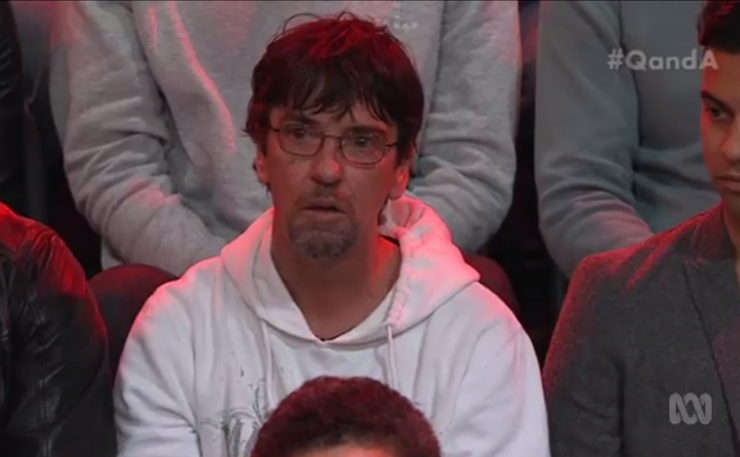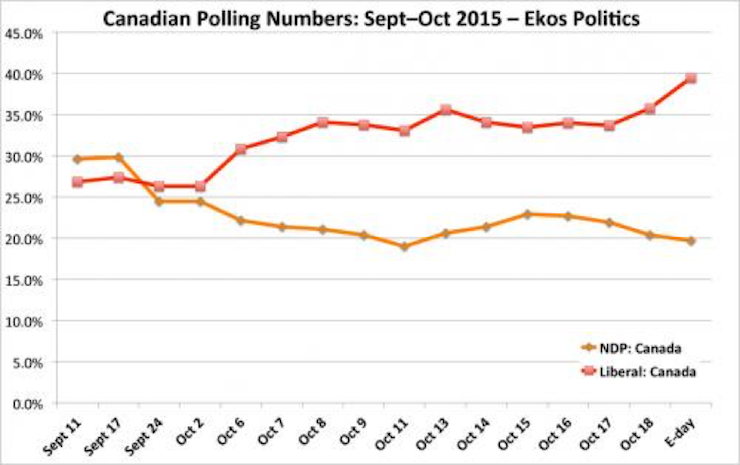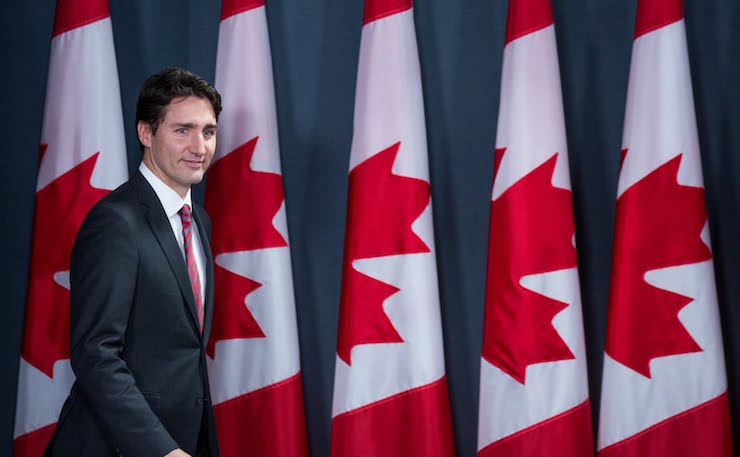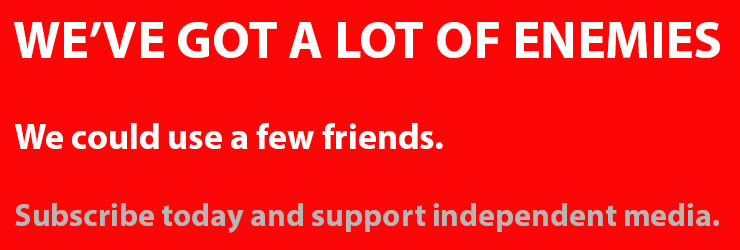The contrasting fates of centre-left parties in the UK and Canada are instructive, and can serve as both a warning and a guide to Labor and the Greens. Centrism doesn’t always pay, writes Liam McLoughlin.
Treasurer Scott Morrison has called for an end to class warfare. In other news, Andrew Bolt wants an end to ill-informed opinions, George Pell wants more honesty and transparency in major institutions, and Tony Abbott is campaigning against three word slogans.
Morrison claims “Australians are over this class warfare, they are over the us and them”.
No Scott, what they are over is your brand of class warfare: the merciless exploitation of the most vulnerable. They are fed up with the way your government continues to siphon off wealth to the upper classes at the expense of ordinary people. They are sick of your “jobs and growth” mantra and they are wary of your impeccable credentials as a snake oil salesman. They grow tired of the lies you peddle about pie size and boat height in the absence of a social conscience.
A recent article in the Saturday Paper by Mike Seccombe presents overwhelming evidence against the government’s “voodoo economics”. Seccombe quotes chief economist from The Australia Institute, Richard Denniss, on the budget’s spending priorities: “47 per cent of the value of those personal tax cuts goes to the top one per cent of income earners. 75 per cent goes to the top 10 per cent. Zero goes to the bottom 65 or so per cent.”
The argument justifying the “jobs and growth” budget is essentially that reducing tax and deregulating capital will benefit all. Evidence shows this is patently false. A 2012 study by the US Congressional Research Service found no correlation between tax paid by the rich and economic growth.
Seccombe also points to analysis by the Australian Council of Social Services showing Australia’s inequality is growing faster than almost all other developed countries. The top 20 per cent are 70 times wealthier than the bottom 20 per cent.
The hollowness of the “jobs and growth” slogan is also illustrated by data from the Australian Bureau of Statistics. It shows private business investment trending down over recent decades. Over a similar period, corporate tax rates have been drastically reduced: from 49 per cent in 1986 to 30 per cent today. In addition, rates of economic growth were higher and unemployment was lower when corporate taxes were higher. As company tax rates have been slashed, so has the share of GDP going to wages. Capital’s share of GDP has skyrocketed. In short, according to Seccombe, “business is inclined to simply pocket the benefits of tax cuts”.
Enter part-time Q&A audience member and full-time legend Duncan Storrar, who put this question to the panel on Monday night.

“I’ve got a disability and a low education, that means I’ve spent my whole life working for minimum wage. You’re gonna lift the tax-free threshold for rich people. If you lift my tax free threshold, that changes my life. That means I get to say to my little girls: ‘Daddy’s not broke this weekend. We can go to the pictures’ Rich people don’t even notice their tax-free threshold lift. Why don’t I get it? Why do they get it?”
Assistant Treasurer Kelly O’Dwyer elected against the truthful response of “because we rule for the rich” and went with the more conventional pie-based answer.
Duncan’s challenge to the government on why they favour the rich at the expense of those who need assistance leads to two important questions for the Coalition, Labor, and The Greens this election.
- How much should we endorse the right-wing agenda of subsidising the rich and punishing the poor to underpin a narrative of strong economic growth?
- How much should we take up a left narrative of social spending and equity?
The way political parties in the UK and Canada have answered these questions in recent times has loomed large in their electoral fortunes.
In May 2015, voters of Alberta, Canada did what few expected. After 12 consecutive election victories and 44 years of conservative rule, Alberta’s Progressive Conservative Party (PCs) was swept from office. The far more progressive New Democratic Party (NDP) stormed to power with a large majority.
Home to the oil sands and Stephen Harper, Alberta has long been seen as Canada’s most conservative province. The ruling PCs presented the usual toxic neoliberal pairing of low taxes for corporations and high income earners with cuts to the public service, health and education. The NDP ran on a platform of increasing the corporate tax rate and raising income taxes for the top 10 per cent. NDP leader Rachel Notley also promised to reverse spending cuts to health and education.
The PCs slumped from 61 seats in the 2012 election to 10 in 2015, while the NDP surged from 4 seats in 2012 to 53 in 2015.
The NDP in Alberta challenged the neoliberal agenda and was rewarded. By contrast, UK Labour embraced it and was punished.
In the 2015 campaign, Ed Miliband’s Labour Party took its cues from the right. They borrowed anti-immigration rhetoric from the UK Independence Party (UKIP) and made a souvenir mug to prove it. They aped Tory language on welfare and matched the conservatives on austerity. The Shadow Work and Pensions Secretary Rachel Reeves said “Labour was not the party of people on benefits” and they backed a welfare spending cap which bound Labour to Tory cuts. David Cameron promised an extra $8 billion in National Health Service funding which Labour refused to match. Instead of a left-wing agenda of social spending, Miliband announced a “budget responsibility lock” to guarantee annual cuts to the deficit.
On May 7 Labour suffered a crushing defeat – its worst since 1983.

The Institute for Public Policy Research (IPPR) released a study in September 2015 which supports this interpretation. The study found “people were more likely to vote Labour in 2015 when they thought the party was more left-wing and less likely to vote Labour when they thought it was centrist”.
Those parties who presented a social democratic vision for change were handsomely rewarded.
The Scottish National Party opposed austerity, promising increased health and welfare spending as well as a higher minimum wage, more affordable housing and wealth redistribution. Their share of seats rose from six in 2010 to 56 out of a possible 59 in 2015.
The Green Party offered a total rejection of austerity and challenged the economic growth mantra itself. They called for abandoning GDP as measure of economic success to be replaced by Adjusted National Product (ANP). This would account for things like environmental depreciation and unpaid work at home. They gained well over one million votes, nearly five times as many as the previous election in 2010.
This election ad may explain a few of those votes, effectively differentiating the Green Party from the neoliberal consensus.
Six months later the Canadian national election results told a similar story with electoral rewards for veering left and electoral punishment for veering right.
Stephen Harper led the ruling Conservative Party of Canada going into the campaign. His approach to governing was summed up by one commentator as “hateful, vindictive, xenophobic, anti-reason, anti-science, anti-knowledge, anti-common sense, anti-democratic, corporatist, small, narrow, cruel, divisive, lying, manipulative, war-mongering, exclusionary…a toxic slime that leeched across the land poisoning everything it touched.” Think of him as Tony Abbott’s guru.
Much like here in Australia, Stephen Harper forced Canadians into their longest federal campaign in recent memory, starting in early August and lasting 78 days. With Harper badly on the nose after nine years of dreadful government, both opposition parties were in with a chance – Justin Trudeau’s Liberal Party and Tom Mulcair’s NDP. The Liberals occupy the centre of Canadian politics, closest to Australian Labor. The NDP are a left party, closest to the Australian Greens.
Halfway through the campaign the conservative vote stood at 29 per cent, rising to 31 per cent on polling day. At the same time in mid-September, the NDP were the frontrunners with 30 per cent of the vote while the Liberals trailed on 27 per cent. In the last six weeks of the election campaign the NDP vote plummeted to 20 per cent while the Liberal vote climbed to nearly 40 per cent.

What happened?
Canadian climate activist Naomi Klein summed it up: “The Libs ran left and soared. The NDP moved right and crashed.”
A post-mortem by the NDP concluded they made the mistake of running a centrist campaign which “was out of sync with Canada’s desire for a dramatic break” from the conservatives. It found they undercut their own social democratic platform by committing to a balanced budget. The NDP said they’d retain conservative tax cuts for the rich and cuts to the public service.
Mulcair positioned himself as a defender of big business in the leaders’ debate and failed to articulate problems of social inequality.
As a result of this right turn they dropped from 103 seats in 2011 to 44 seats in 2015.
By contrast, Trudeau’s left narrative of change played well in the electorate. Trudeau outflanked Mulcair in the leaders’ debate, ridiculing the NDP leader’s argument that the super-rich are paying their “fair share” of tax. The Liberal platform included higher taxes for those on more than $200,000 a year. Trudeau also promised to run three years of deficits to pay for infrastructure spending.
The reward for moving left was a thumping majority for the Liberals, increasing their share of seats from 77 in 2011 to 184 in 2015.
After three decades of neoliberal hegemony, the political tides are turning. Opposition parties offering alternatives to the free market playbook have excelled in recent times and those who have endorsed the free market agenda have faltered.
While the Coalition’s “jobs and growth” budget shows they are chained to their trickle-down ideology, Labor is showing promising signs of dissent.
Bill Shorten’s budget reply rejected Malcolm Turnbull’s tax cuts for big and medium business and promised to retain the 2 per cent deficit levy on high income earners. Shorten framed the election as about fairness and equity, condemning Morrison’s “budget for big business over battlers”. He said “three-quarters of Australian workers won’t receive any tax relief from this budget but will disproportionately suffer from cuts to schools, hospitals, Medicare and family support they count on”. Shorten is effectively positioning Labour to the left of the Coalition, spurning some aspects of neoliberalism in favour of an emphasis on social spending and equity.
This is not a ringing endorsement for Labor. They have followed the Liberals to some of the darkest depths of Australia’s policy history on national security, defence spending, surveillance and worst of all, refugee policy. I don’t understand how a progressive voter could use their one chance in three years to endorse a party which came up with the PNG solution, supports boat turnbacks and prefers the imprisonment and abuse of asylum seekers in secretive offshore prison camps to settling refugees in Australia.
Nonetheless, unless the Greens miraculously surge to a governing position in the next few weeks, Labor is by far the lesser of two possible evils. Shorten is taking steps in the right direction to win the July election.
The Greens have more consistently rejected aspects of neoliberalism and have always presented a more coherent social democratic agenda than Labor. So long as we see more about Greens policies like the “millionaire’s tax” and investment in infrastructure and their approach to health, education, climate change, housing affordability and refugees and less about the “Greens’ new pragmatism” and possible preference deals with the Liberals, they should do very well in July.
Minimum wage earner Duncan Storrar struck a chord with Australians this week when he illustrated the terrible inequity perpetrated by this government.
Let’s hope Labor and the Greens can strike a similar chord and return Malcolm to his spiritual home in the banking sector.
Donate To New Matilda
New Matilda is a small, independent media outlet. We survive through reader contributions, and never losing a lawsuit. If you got something from this article, giving something back helps us to continue speaking truth to power. Every little bit counts.





